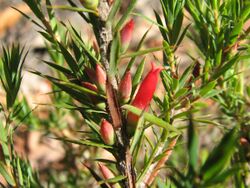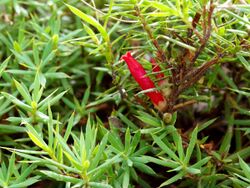Biology:Styphelia humifusa
| Styphelia humifusa | |
|---|---|

| |

| |
| Scientific classification | |
| Kingdom: | Plantae |
| Clade: | Tracheophytes |
| Clade: | Angiosperms |
| Clade: | Eudicots |
| Clade: | Asterids |
| Order: | Ericales |
| Family: | Ericaceae |
| Genus: | Styphelia |
| Species: | S. humifusa
|
| Binomial name | |
| Styphelia humifusa (Cav.) Pers.[1]
| |
| Synonyms[1] | |
| |
Styphelia humifusa, commonly known as native cranberry or cranberry heath, is a small prostrate shrub or groundcover in the heath family Ericaceae. The species is endemic to south-eastern Australia .
Description
Styphelia humifusa grows as a spreading mat-like shrub up to 50 cm (20 in) high and 0.5 to 1.5 m (20 in to 5 ft) across.[2] Its hairy stems bear blue-green pine-like acute leaves 0.5-1.2 cm (0.2-0.5 in) long. The tubular flowers are up to 2 cm (0.8 in) long and appear from February to June, and are all red, unlike the red and green flowers of A. pinifolium. Flowers are followed by green globular berries around 0.4-0.6 cm (0.2 in) in diameter, which become reddish as they ripen.[3]
Taxonomy
Styphelia humifusa was first formally described in 1797 by Antonio José Cavanilles who gave it the name Ventenatia humifusa in his Icones et Descriptiones Plantarum.[4][5] In 1805, Christiaan Hendrik Persoon transferred the species to Styphelia as S. humifusa in his book Synopsis plantarum, seu enchiridium botanicum.[1]
Common names
Common names include cranberry heath and native cranberry, as the fruits were eaten by early settlers.[2] An old name is juniper-leaved astroloma.[6] A common nineteenth century name was the ground berry.[7]
Distribution and habitat
The range is in southeastern Australia, from Port Stephens in the north in eastern and central New South Wales, into Victoria, south-eastern South Australia and Tasmania.[3][8][9] It is generally found in open woodland, both on sandstone and clay soils,[3] as well as upland bogs. Associated plant species include Eucalyptus fibrosa, Eucalyptus sideroxylon, and Kunzea ambigua.[10]
Ecology
The eastern bettong (Bettongia gaimardi) eats the fruit.[11]
Uses
Requiring good drainage in the garden, Styphelia humifusa can be grown in rockeries.[12] The juicy berries are edible, although they are mostly made up of a large seed. They can be used to make jams or preserves.[2] The flavour of the berries has been described as "sickly sweet".[6]
The 1889 book 'The Useful Native Plants of Australia records that "The fruits of these dwarf shrubs have a viscid sweetish pulp, with a relatively large stone. The pulp is described by some as being "apple flavoured..."[7]
References
- ↑ 1.0 1.1 1.2 "Styphelia humifusa". Plants of the World Online. https://powo.science.kew.org/taxon/urn:lsid:ipni.org:names:325797-1#synonyms.
- ↑ 2.0 2.1 2.2 Elliot, Rodger W.; Jones, David L.; Blake, Trevor (1985). Encyclopaedia of Australian Plants Suitable for Cultivation: Vol. 2. Port Melbourne: Lothian Press. p. 248. ISBN 0-85091-143-5.
- ↑ 3.0 3.1 3.2 Native Plants of the Sydney District: An Identification Guide (2nd ed.). Kenthurst, NSW: Kangaroo Press. 2000. p. 87. ISBN 0-7318-1031-7.
- ↑ "Ventenatia humifusa". APNI. https://id.biodiversity.org.au/instance/apni/481131.
- ↑ Cavanilles, Antonio J. (1797). Icones et Descriptiones Plantarum. 4. Madrid. p. 28. https://bibdigital.rjb.csic.es/viewer/9682/?offset=#page=32&viewer=picture&o=bookmark&n=0&q=. Retrieved 12 September 2023.
- ↑ 6.0 6.1 Bennett, George (1860). Gatherings of a naturalist in Australasia: being observations principally on the animal and vegetable productions of New South Wales, New Zealand, and some of the austral islands. John Van Voorst. pp. 370. https://archive.org/details/in.ernet.dli.2015.221131. "astroloma humifusum."
- ↑ 7.0 7.1 J. H. Maiden (1889). The useful native plants of Australia : Including Tasmania. Turner and Henderson, Sydney. https://primo-slnsw.hosted.exlibrisgroup.com/primo-explore/fulldisplay?docid=SLNSW_ALMA21105097830002626&context=L&vid=SLNSW&search_scope=EEA&tab=default_tab&lang=en_US. p. 8
- ↑ J. M. Powell. "New South Wales Flora Online: Astroloma humifusum". Royal Botanic Gardens & Domain Trust, Sydney, Australia. http://plantnet.rbgsyd.nsw.gov.au/cgi-bin/NSWfl.pl?page=nswfl&lvl=sp&name=Astroloma~humifusum.
- ↑ "Astroloma humifusum". Electronic Flora of South Australia Fact Sheet. State Herbarium of South Australia. http://www.flora.sa.gov.au/cgi-bin/speciesfacts_display.cgi?genus=Astroloma&species=humifusum. Retrieved 3 September 2011.
- ↑ Benson, Doug; McDougall, Lyn (1995). "Ecology of Sydney Plants 3: families Cabombaceae to Eupomatiaceae". Cunninghamia 4 (2): 217–429. https://www.rbgsyd.nsw.gov.au/RoyalBotanicGarden/media/RBG/Science/Cunninghamia/Volume%204%20-%201995/Volume-4(2)-1995-Cun4Ben217-431.pdf. Retrieved 2016-05-11.
- ↑ Hume, Ian D. (1999). Marsupial nutrition. Cambridge University Press. pp. 319. ISBN 9780521595551. https://books.google.com/books?id=v55COlrupRQC&q=astroloma+humifusum&pg=PA319.
- ↑ Gray, Marilyn (2010). "Astroloma humifusum". Archived from the original on 29 March 2011. https://web.archive.org/web/20110329114759/http://www.yarraranges.vic.gov.au/Residents/Yarra_Ranges_Plant_Directory/Yarra_Ranges_Local_Plant_Directory/Lower_Storey/Herbs_and_Groundcovers_1m/Astroloma_humifusum. Retrieved 15 August 2011.
Wikidata ☰ Q65950044 entry
 |

